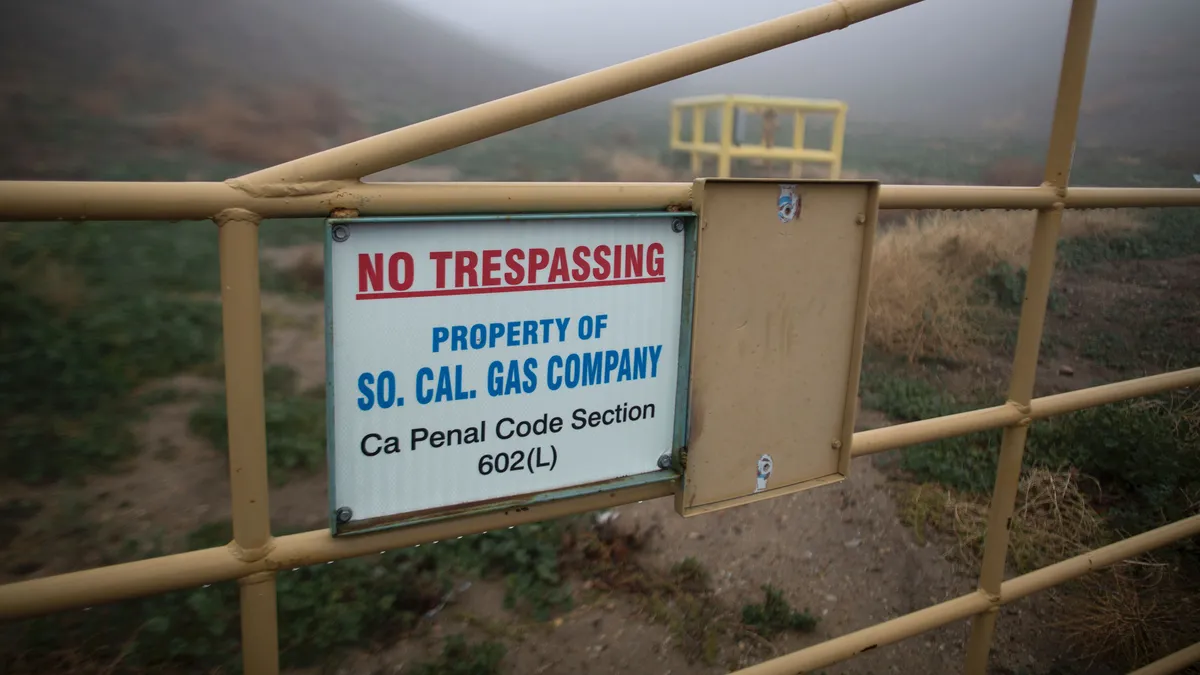Dive Brief:
- The California Public Utilities Commission (CPUC) last Friday released a draft ruling that would require Southern California Edison (SCE) to hold an expedited procurement solicitation for energy storage capacity to help alleviate outage concerns caused by the Aliso Canyon gas leak.
- Discovered last October, the worst methane leak in U.S. history has left the Southern California Gas's Aliso Canyon gas storage facility with less than one-fifth of its capacity. In response, Gov. Jerry Brown called on the CPUC in January to take action to ensure reliable supplies of gas and electricity.
- Days before issuing the draft ruling for an expedited storage procurement, the CPUC called for increased efficiency spending from SCE to bring down electricity demand. Without any action, California consumers could face up to 14 days of rolling blackouts this summer, a recent report from California energy agencies found.
Dive Insight:
Time is of the essence for California energy officials, who are rushing to firm up electric reliability in the LA Basin ahead of the coming summer and winter months, when the state's energy demand can reach its peaks.
Last month, a joint report from the CPUC, the state energy office, the California ISO and the Los Angeles Department of Water & Power warned that customers could have to curtail their usage or even face blackouts if no action is taken. They outlined an 18-point action plan for the region, and regulators in early May called on SCE to increase efficiency spending as a mitigation measure.
But even those measures may not be enough to eliminate reliability concerns, the CPUC said in its draft decision on Friday. Now, the commission is turning its attention to storage with a focus on technologies that can be deployed quickly.
Commissioners identified energy storage as a potential solution for the gas supply issues in southern California because "they can be fast-responding, firm, and dispatchable," as well as their ability to "be potentially constructed interconnected and deployed on a short timeline."
In the draft ruling, regulators direct SCE to solicit "in-front-of-the-meter (IFOM) energy storage that can be operational by December 31, 2016" and that help "to alleviate electric reliability concerns associated with the partial shutdown of the Alison Canyon Gas Storage Facility."
Resources in this solicitation should be consistent with SCE's storage procurement authorizations under its LA Basin local capacity requirement, which sets parameters for resource procurements in certain geographic areas.
New storage buys should also be price-competitive with previous SCE storage solicitations, regulators said. Because it is unclear how long the situation at Aliso Canyon will last, SCE "may enter into contracts with terms of 10 years or less."
The draft decision is not a final ruling from the CPUC, but provides a strong indication of the commissioners' thinking on the issue. Regulators will vote on the draft decision in their May 26 meeting and the commission will accept comments on the draft until May 19.
While the natural gas constraints in southern California are creating short-term reliability issues, they could also provide lessons for how to reduce the need for fossil fuels on the grid. Throughout the crafting of the Aliso Canyon Action Plan, environmentalists pressed officials to use the crisis to position the state to transition away from its growing reliance on natural gas.
While the action plan is still more focused on gas supply than greens would have liked, state officials are starting to sing a similar tune:
“The near term challenge is to reduce Southern California’s reliance on Aliso Canyon,” Robert B. Weisenmiller, chair of the California Energy Commission, wrote to Utility Dive last month. “And there is a long-term trend to reduce our reliance on natural gas.”














